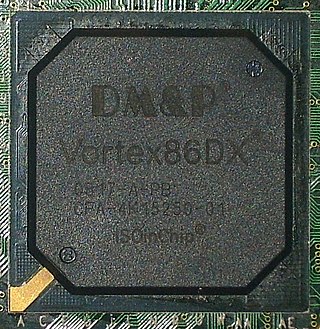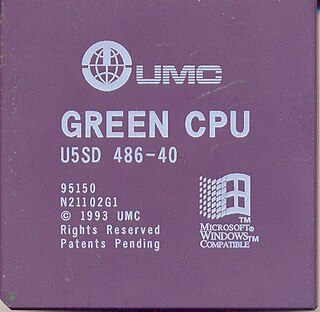
The Intel 386, originally released as 80386 and later renamed i386, is a 32-bit microprocessor introduced in 1985. The first versions had 275,000 transistors and were the CPU of many workstations and high-end personal computers of the time. As the original implementation of the 32-bit extension of the 80286 architecture, the i386 instruction set, programming model, and binary encodings are still the common denominator for all 32-bit x86 processors, which is termed the i386 architecture, x86, or IA-32, depending on context.

The Intel 486, officially named i486 and also known as 80486, is a microprocessor. It is a higher-performance follow-up to the Intel 386. The i486 was introduced in 1989. It represents the fourth generation of binary compatible CPUs following the 8086 of 1978, the Intel 80286 of 1982, and 1985's i386.

The i486SX was a microprocessor originally released by Intel in 1991. It was a modified Intel i486DX microprocessor with its floating-point unit (FPU) disabled. It was intended as a lower-cost CPU for use in low-end systems, adapting the SX suffix of the earlier i386SX in order to connote a lower-cost option. However, unlike the i386SX, which had a 16-bit external data bus and a 24-bit external address bus, the i486SX was entirely 32-bit.

The Intel 80186, also known as the iAPX 186, or just 186, is a microprocessor and microcontroller introduced in 1982. It was based on the Intel 8086 and, like it, had a 16-bit external data bus multiplexed with a 20-bit address bus. The 80188 variant, with an 8-bit external data bus was also available.

The Pentium is a fifth generation, 32-bit x86 microprocessor that was introduced by Intel on March 22, 1993, as the very first CPU in the Pentium brand. It was instruction set compatible with the 80486 but was a new and very different microarchitecture design from previous iterations. The P5 Pentium was the first superscalar x86 microarchitecture and the world's first superscalar microprocessor to be in mass production—meaning it generally executes at least 2 instructions per clock mainly because of a design-first dual integer pipeline design previously thought impossible to implement on a CISC microarchitecture. Additional features include a faster floating-point unit, wider data bus, separate code and data caches, and many other techniques and features to enhance performance and support security, encryption, and multiprocessing, for workstations and servers when compared to the next best previous industry standard processor implementation before it, the Intel 80486.
The Intel i860 is a RISC microprocessor design introduced by Intel in 1989. It is one of Intel's first attempts at an entirely new, high-end instruction set architecture since the failed Intel iAPX 432 from the beginning of the 1980s. It was the world's first million-transistor chip. It was released with considerable fanfare, slightly obscuring the earlier Intel i960, which was successful in some niches of embedded systems. The i860 never achieved commercial success and the project was terminated in the mid-1990s.

Cyrix Corporation was a microprocessor developer that was founded in 1988 in Richardson, Texas, as a specialist supplier of floating point units for 286 and 386 microprocessors. The company was founded by Tom Brightman and Jerry Rogers.

The Pentium Pro is a sixth-generation x86 microprocessor developed and manufactured by Intel and introduced on November 1, 1995. It introduced the P6 microarchitecture and was originally intended to replace the original Pentium in a full range of applications. While the Pentium and Pentium MMX had 3.1 and 4.5 million transistors, respectively, the Pentium Pro contained 5.5 million transistors. Later, it was reduced to a more narrow role as a server and high-end desktop processor and was used in supercomputers like ASCI Red, the first computer to reach the trillion floating point operations per second (teraFLOPS) performance mark. The Pentium Pro was capable of both dual- and quad-processor configurations. It only came in one form factor, the relatively large rectangular Socket 8. The Pentium Pro was succeeded by the Pentium II Xeon in 1998.
The Pentium OverDrive was a microprocessor marketing brand name used by Intel, to cover a variety of consumer upgrade products sold in the mid-1990s. It was originally released for 486 motherboards, and later some Pentium sockets. Intel dropped the brand, as it failed to appeal to corporate buyers, and discouraged new system sales.

Intel's i486 OverDrive processors are a category of various Intel 80486s that were produced with the designated purpose of being used to upgrade personal computers. The OverDrives typically possessed qualities different from 'standard' i486s with the same speed steppings. Those included built-in voltage regulators, different pin-outs, write-back cache instead of write-through cache, built-in heatsinks, and fanless operation — features that made them more able to work where an ordinary edition of a particular model would not.

The Am386 CPU is a 100%-compatible clone of the Intel 80386 design released by AMD in March 1991. It sold millions of units, positioning AMD as a legitimate competitor to Intel, rather than being merely a second source for x86 CPUs.
x87 is a floating-point-related subset of the x86 architecture instruction set. It originated as an extension of the 8086 instruction set in the form of optional floating-point coprocessors that worked in tandem with corresponding x86 CPUs. These microchips had names ending in "87". This was also known as the NPX. Like other extensions to the basic instruction set, x87 instructions are not strictly needed to construct working programs, but provide hardware and microcode implementations of common numerical tasks, allowing these tasks to be performed much faster than corresponding machine code routines can. The x87 instruction set includes instructions for basic floating-point operations such as addition, subtraction and comparison, but also for more complex numerical operations, such as the computation of the tangent function and its inverse, for example.

The Intel 80387SX is the math coprocessor, also called an FPU, for the Intel 80386SX microprocessor. Introduced in 1987, it was used to perform floating-point arithmetic operations directly in hardware. The coprocessor was designed only to work with the 386SX, rather than the standard 386DX. This was because the original 80387 could not communicate with the altered 16 bit data bus of the 386SX, which was modified from the original 386DX's 32 bit data bus. The 387SX uses a 68-pin PLCC socket, just like some variants of the 80286 and the less common 80186 CPU, and was made in speeds ranging from 16 MHz to 33 MHz, matching the clock speed range of the Intel manufactured 386SX. Some chips like the IIT 3C87SX could get up to 40 MHz, matching the clock speeds of the fastest 386SX CPUs.

The R4000 is a microprocessor developed by MIPS Computer Systems that implements the MIPS III instruction set architecture (ISA). Officially announced on 1 October 1991, it was one of the first 64-bit microprocessors and the first MIPS III implementation. In the early 1990s, when RISC microprocessors were expected to replace CISC microprocessors such as the Intel i486, the R4000 was selected to be the microprocessor of the Advanced Computing Environment (ACE), an industry standard that intended to define a common RISC platform. ACE ultimately failed for a number of reasons, but the R4000 found success in the workstation and server markets.
The 386SLC was an Intel-licensed version of the 386SX, developed and manufactured by IBM in 1991. It included power-management capabilities and an 8KB internal CPU cache, which enabled it to yield comparable performance to 386DX processors of the same clock speed, which were considerably more expensive. Known inside IBM as "Super Little Chip" for its initials, it was used in the IBM PS/2 35, 40 and 56 Series and in the IBM PS/ValuePoint 325T, but never gained much market share. This was mainly due to an agreement with Intel, in which IBM was not allowed to sell their CPUs if they were not part of a system or upgrade board. It was also marketed as an optional upgrade for 8086-equipped IBM PS/2 25 Series computers.

The Vortex86 is a computing system-on-a-chip (SoC) based on a core compatible with the x86 microprocessor family. It is produced by DM&P Electronics, but originated with Rise Technology.
The R4200 is a microprocessor designed by MIPS Technologies, Inc. (MTI) that implemented the MIPS III instruction set architecture (ISA). It was also known as the VRX during development. The microprocessor was licensed to NEC, and the company fabricated and marketed it as the VR4200. The first VR4200, an 80 MHz part, was introduced in 1993. A faster 100 MHz part became available in 1994.

The UMC Green CPU was an x86-compatible microprocessor produced by UMC, a Taiwanese semiconductor company, in the early- to mid-1990s. It was offered as an alternative to the Intel 80486 with which it was pin compatible, enabling it to be installed in most 80486 motherboards. All models had power management features intended to reduce electricity consumption.

The Cyrix Cx486 was an x86 microprocessor designed by Cyrix. It primarily competed with the Intel 486 with which it was software compatible, would operate in the same motherboards provided proper support by the BIOS was available and generally showed comparable performance. The chip also competed with parts from AMD and UMC.















